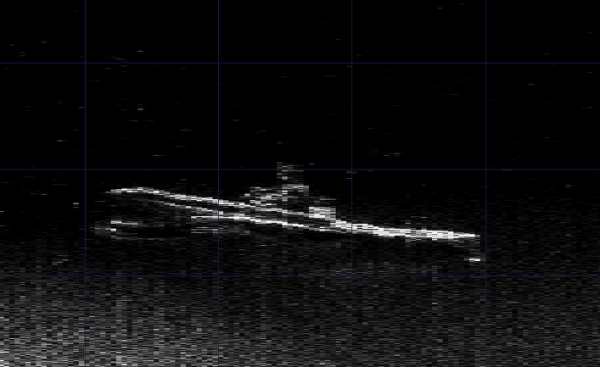
Dark autumn evening Peer, Collin (Per Sollin) and his wife suddenly heard a terrible noise in the Bay.
The next morning when their neighbor, Starkman Bertil (Bertil Sturkman) checked their fishing nets, they learned its source.
Soviet submarine s-363 ran aground in a military restricted area off the coast of Karlskrona.
This news has thundered for the whole world, beginning a 10-day intensive diplomacy. Never cold war for Sweden do not show as significantly, in October 1981.
Sweden, autumn 1981.
Bjorn Borg (Björn Borg) lost the place in the world ranking in tennis, John McEnroe (John McEnroe). Bourgeois three-party government split. One of the few reasons for joy that this fall on TV after nine-year hiatus returned transfer “Angle Holanda” (“Hylands hörna”).
It’s dark times, times of crisis. Low situation 70 years holds the economy. The number of layoffs reaching record levels.
As Sweden will be able to maintain well-being? Isn’t it time to cut the defense budget? Here are some questions raised in public debate.
But it is also a time of anxiety. Because of atomic weapons, the arms race, from foreign submarines. Because of the Russian.
After several years of decreasing voltage and of the signing of the disarmament treaties, the tone of communication between the West and the East is once again becoming tougher. The Soviet Union in 1979 is included in Afghanistan — the US is starting to support Islamist rebel groups. Moscow in 1980 organizes the Olympic games US boycott them. Ronald Reagan takes over the White house January 1981 and begins a new wave of the arms race.
The cold war is back.
***
12 James bond film “for your eyes Only”, Communist scum, meaner than ever.
Sweden balances between NATO and the Warsaw Treaty Organization, at least officially.
Military forces — organization, which at that time covers a large part of the population of Sweden. Conscription applies to all: those who refuse could end up in jail.
Those who have good enough a new car, get the paper where it is written that it should be placed at the disposal of the armed forces in case of war.
In the 70-ies wrote about the number of incidents with submarines in Swedish waters, but in September 1980, the voltage here increases. Unknown submarine did not leave the course when the Swedish fleet was facing her at howuser archipelago, South of Stockholm.
Refers to the “twilight”, a military expression that describes a threatening situation between war and peace. Describes how the Soviet Union plans to neutralize the entire Swedish defence in a few hours, what are they going to destroy the pilots of the fighters and senior leaders on the same day when you send troops capture.
Perhaps it is no coincidence that in October 1981 Astrid Lindgren publishes her “Ronia, the robber’s daughter” — the story many would later describe as the study of psychology and logic of the cold war.
***
Toruser, October 27, 1981
Fisherman Starkman, Bertil (Bertil Sturkman) absolutely thrilled when enters the kitchen colleagues of Ingvar Svensson, near Karlskrona.
“Forumshare gone aground submarine! The men on the boat were pointing their machine guns at me when I came closer!”
Son-in-law of Ingvar Svensson Peru Zollino was 61 years old when the newspaper Expressen met him in 2013. It was his day off after a shift at the fire station. He was sitting on the kitchen sofa with her nine month old son.
The evening before, Starkman ran into their kitchen, Peer, Collin and his wife wondered what was going on. From the sea, were heard clapping, and their son couldn’t sleep again after the night feeding. But the couple decided that it was Swedish sailors who carried out some exercises.
Bertil, Starkman worried infrequently. But now he said, barely taking a breath, which is stranded at the village Malcarne submarine, and soldiers its Board had sent him a weapon. He didn’t recognize the flag on the ship, but it was definitely not the Swedish flag — this he was sure.
Starkman, visibly shaken and after a while goes. It provides act to Ingvar Svensson.
After a short meeting with the son-in-law Svensson calls the naval base in Karlskrona.
Some hours later, the Peer Collin makes another call — in “a Thousand tips”, call for readers to the newspaper Kvällsposten. Daily Newspapers have gone to print, but the reporter Sven-Olof Gunnarsson (Sven-Olof Gunnarsson) shouts to his colleagues that he had arrived, cool stuff, and everyone rushes to help prepare a new version number.
When Kvällsposten hits the stores, right after lunch, the news emblazoned on the front pages.
***
Per Collin leaves son in-law and borrow his motorboat. He realizes that the day in the archipelago of Karlskrona in front of the story and wants to see everything with your own eyes.
On the clock in about 11 days when he sees S-363.
At the same time, there are looking ship in the fleet Smyge. Away Peer, Collin sees a lone man climbs on Board the submarine.
Karl Andersson (Karl Andersson), who recently turned 50 years old, chief of staff, it seems that it is just impossible.
He just got off the phone with fisherman Ingvar Svensson, who stated that an unknown submarine ran aground in the Bay.
Karl Andersson called me and checked where the Swedish submarines. In the fjord Goatherder none of them. He thinks that perhaps the commander-in-chief brought in a sea of decommissioned submarine and put her aground to experience the Navy as exercises.
The situation is unique.
Carl Andersson has clear instructions on how he and his colleagues must act in the case that the submarine will float on the surface or under water close to the Swedish military safety zone. But in the rules nothing is said about what to do with the submarine, stranded.
“What the devil are stranded in the fjord Karlskrona, anyone in the most morbid imagination could not come to a head,” said Carl Andersson, when he is in 2013, told Expressen about the incident.
He’s almost certain that Ingvar Svensson is wrong. At the same time there is a growing sense of confusion, and Karl Andersson finally decides to go there and see. He takes Smyge patrol boat and six sailors and puts the course at the place where allegedly on the rocks is a sub.
Karl Andersson, who joined the Navy in 1947, half of his professional career was spent in military exercises in the waters around Blekinge. One thing he could say for sure: Goatherder — water submarines.
“Even we, knowing those waters like the back of their hand, not would have taken back his submarine”.
But after less than an hour sea journey, he saw her.
“It was a little hazy, but from about 100 meters I saw that it is the Soviet flag. We in the armed forces love to joke, but these jokes never touch other people’s flags. If not before, then certainly now I understand that this is not the doctrine of the armed forces, and the most that neither is reality.”
Karl Andersson sends on the radio the first report to his superior, the commander Lennart Forsman (Lennart Forsman) at the naval base. In this situation, Andersson might decide to go back to bring reinforcements and to come up with some huge “tractor”. But he thought that it would be foolish not to know what’s going on, if he anyway already.
Its task is to find out what the name of the boat, and who her commander. He is not afraid.
“Our ship Smyge equipped with a gun, and we are on the surface. I see that the Russians are stuck. Of course, they can shoot me with his weapon, but then resentment on the part of the Swedes will only get worse”.
Karl Andersson seems that Russians look very dull. Despite the fact that it’s freezing outside and windy, 59 members of the crew hot. Smyge caught up with submarine and moored on her port side.
On hour 11 of day when the commander Karl Andersson one fit aboard a submarine.
“Do you speak english?” — asked the commander of the Russian authorities, but receives no response. Russian just stare into the deck.
When Karl Andersson tries a German, performed by one of the crew members. “Nur ein bisschen”, — he apologizes — “only a little”.
Due to the fact that Russian soldiers may transfer, Karl Andersson finds out that diesel Soviet submarine of the Whiskey class by NATO classification (submarines of project 613 in the Soviet) is called the s-363. Commander on it, Anatoly Gushchin, captain of the third rank.
When Karl Andersson is asking what the Russian was doing, they answered that they came from the naval base “Baltic” in Kaliningrad, and that they had a failure in the navigation system.
“So where do you think you are?” asked Andersson.
One of the crew members are sent down in a submarine to bring the navigation map. He returned with a map folded under one arm, deploying its officers, and Karl Andersson manages to see that this is a very detailed map.
Come on shout and quickly sent back down under the deck for another card. Her Russian show in the southern part of the Baltic sea say that I believe that are there.
“When I give them the first information about the location and show up that they are in Blekinge, they look terribly amused. They believed that I was in the Danish island of Ertholmene, or Bornholm”.
Karl Andersson ready to laugh when one of the Russian command, chief of staff Joseph Avrukevich, says that he is an expert in navigation. Also on Board is the captain-Lieutenant Vasily Besedin, Deputy captain and political officer.
The Russians claim that they have a problem with the gyrocompass — a compass that does not depend on errors of the magnetic system, and is displayed at a constant angle to the earth’s axis — and no radio direction finder, a navigation system and echo sounder.
Karl Andersson is hard to believe that all four navigation system ceased to function at the same time, and it requires permission to go below to look at the equipment. The Swedish commander finds nothing broken. The finder works great as a sounder. The navigation system as he understand them, there are acceptable.
Even now — alone among the 59 Russian — Carl Andersson has no fear. Russian officers invited him to dinner. He gets a plate of tuna in tomato sauce and a plate of sardines in oil.
When Andersson served the pate with jelly-like surface on black bread, the commanders of the boats seem to be very proud.
“”Es ist fleisch” — “This meat,” explains the translator adds that the meat, incidentally, is not at all the Russian ships, but on submarines”.
Karl Andersson says that it is delicious, but don’t understand why they are proud to receive the meat.
“Pretty stupid from my side was bryaknut that all Swedish ships eat meat, although it is true. But the Russians think I’m a braggart and a liar”.
The situation did not improve and that the Swede refuses drinks to the table.
Each plate is worth two cups. One contains a fairly acidic white wine, the other to the brim poured something called cherry juice.
“To your health!” — toasting the Russian commanders and in one gulp tilt the glasses with red liquid in the pharynx.
“My lips are paralyzed by a terrible poison. The atmosphere at the table becomes incredibly tense when I just prigublyayut drink. I become a persona non grata,” recalls Carl Andersson in 2013.
Later, he learns that it is on the orders of Moscow, he was offered “tea in Russian” — 96% alcohol for disinfection local applications, flavored with a small amount of juice.
“The goal was to get me drunk to death and to get permission to let in Swedish waters, the Russian tug, which they would be dragged out. This, of course, unthinkable.”
Meanwhile, Torunlar called the police and the coast guard. S-363 made in an iron ring.
Commander Lennart Forsman reports disturbing news, the then commander-in-chief Lennart Meri Jung (Lennart Ljung), which in turn calls the Prime Minister Torbjorn Falldin (Thorbjörn Fälldin).
Foreign Minister and Deputy Prime Minister Ula, Ullsten (Ola Ullsten) sitting in his office at the foreign Ministry when it comes to the Cabinet Secretary Leif, Lapland (Leif Leifland) and says that it was a call from the leadership of the armed forces.
Ullsten understands that we need to deal with a very sensitive issue. The foreign Ministry sends the Soviet Union a short note of protest and calls for meeting of country’s Ambassador Mikhail Yakovlev.
“Yakovlev conservative, elderly people and shows no feelings. He is correct with his employee, which translates,” recalls Ola, Ullsten in 2013.
Yakovlev asks the permission of the Soviet warships to enter into a military secure area and pick up the submarine. Ullsten requirement, the Russians immediately rejected. One Soviet ship in the Swedish military restricted area is already too many.
From the Swedish boat-363 from the beginning was seen as an exclusively diplomatic issue. About any military action the question.
“We decided on two things,” said Ula, Ullsten, — “to adhere to international law and not to demand from the Russians that they will not be able to perform. First and foremost, we were interested in the fact that it is not delayed at the time.”
The latter was harder to decide than I thought, Ulmsten and his colleagues in the government. Every time, when the Swedes asked the Soviet diplomats, because of the terrible bureaucracy of the reply took two days.
Soon after came the room Kvällsposten, news gave the Agency Tidningarnas telegrambyrå, and it became the news of the day on Swedish Radio. At 17.10 commander Karl Andersson and his boss, commander Lennart Forsman, held the first press conference at the naval base in Karlskrona.
“Forsman decided early on that Soviet submarine deliberately went into the fjord Karlskrona, and that she was on a spy mission,” — said Carl Andersson newspaper Expressen in 2013.
The commander this skeptical:
“The submarine was too large for such a job. It would be madness to send in the fjord boat that can attract everyone’s attention. It would be wiser to hire a fishing vessel under the Swedish flag.
***
Newspaper Expressen sent in Blekinge Robert Ashberg (Robert Aschberg) and the news Director Roland Aldeheim (Roland Aldeheim) at first believed that one person at the scene will be enough. But the reporter Brannstrom Leif (Leif Brännström) insists. He was sent to Karlskrona on their own plane of the newspaper, and hires a fishing boat to try to get to Forumshare.
The next day all the Newspapers are filled With reports-363.
“That’s a submarine, in broad daylight, this time to deny is absolutely impossible. She stands there as a visible proof that the various events that took place off the coast of Sweden in recent years have the unpleasant overtones of what was feared,” says the analysis on the front page.
The operation takes place along with growing media attention. Commander Karl Andersson changes patrol boat Smyge on the icebreaker Thule.
The Swedish armed forces responded to requests from the Russian crew on the drinking water and tobacco. The submarine s-363 is also allowed to contact the base in Kaliningrad radio on short wave.
“We have identified the sub a certain frequency and instructed the telegrapher to send a simple text in Russian language. Needless to say, we listened to the radio. When they tried several times to go to the code, we have included interference” — says Karl Andersson, 2013.
The drama increases when the leadership of the armed forces immediately afterwards says that the Soviet Union, it seems, ignores the refusal of the Minister of foreign Affairs Uly Ullsten let-363 vehicle for towing. The Soviet rescue ship for submarines accompanied by two destroyers armed with missiles, and several smaller warships, heading for Karlskrona.
Reservists mobilized from vacation to Karlskrona fly fighter jets, located on the island of Hastholmen, increasing patrols in Swedish territorial waters. Patrol ships have been reinforcing the division of torpedo boats from Stockholm to control what politicians call “the most serious violation since the second world war.”
The Swedes need to interrogate the captain of the submarine that the Soviet Union does not want to go.
***
On the morning of October 29, the armed forces organized for the press ship to the whole world with my own eyes could see the stranded boat. The Swedish plane “Viggen” flying a hundred meters over the scene, and then makes another span of just 25 metres.
“It was the roar and smelled of kerosene. It’s the air force decided to demonstrate its power,” recalls commander Karl Andersson.
One of the members of the command submarine, located in her tower, lost patience and began to signal that the presence of the press-vehicle is undesirable. The Soviet command did not seem aware that the boat on the rocks has already become world news.
“They tried to negotiate and said that “if we keep our mouth shut about what happened, then you have to sit quietly”. I laughed and said I will never have enough money to be able to force to sit quietly pilot “Viggen” and all journalists,” — said Carl Andersson newspaper Expressen in 2013.
In the Soviet Union the incident, on the contrary, suppressed. While s-363 is in Swedish waters, about her fate in the Soviet press does not mention anything.
Around lunch time the Soviet tug showed up at the archipelago Utklippan related to Karlskrona the commune. Just some hours before that, another submarine was relegated from the Swedish waters the Swedish Navy.
Swedish submarine Neptun sends warning signals and trying to block let it tow the ship, but it is faster and continues to strive in Rosefielde, where the S-363.
The Swedish icebreaker Thule is located across the entrance of the Gulf to complicate the rescue operation, “Neptune” continues to drive away towing the ship, which finally deviates from the direction Karlshamn and returns to the rest of the Soviet ships.
The Swedish military is meanwhile preparing to make s-363 in the port of Karlskrona. The coast guard and paratroopers plan to defeat the Soviet command of the boat with tear gas in order to transfer them to the Swedish police. Begin to build a camp for detainees with medical care, to business connect attorney of the County where you live.
At this point, the Swedes don’t know that a submarine captain Gushchin received the order to blow up s-363 in the event of an attempted assault.
***
Thursday evening a dozen Soviet ships gathered in the waters off the Swedish military restricted areas. Swedish submarine Neptun runs under water with a lighted floodlight between the Soviet ships.
In the documentary Yakima Linda (Joakim Lindhé) and Peer Anders Rydelius (Per Anders Rudelius), shown on TV channel SVT, “the Submarine s-363 was broke” (2006), the representative of the Navy says that the Swedes began to use the frequency jump, which is only used in case of war, when five Soviet warships on the high speed close to the Swedish border. Frequency jumps signaled the Soviet violators that the Swedes are ready to open fire, but in actual fact, the Swedish ships have not had time to prepare charges.
There were many nervous moments before the Soviet ships — 30 seconds after the start of use of frequency surges — slowed and stopped.
KGB Colonel Boris Grigoriev explained in the same documentary on channel SVT that until the Soviet Union is not too worried, and that they did not believe that Sweden will increase the tone.
After the Swedes began to use the frequency jump, the Soviet Union indicated through the Embassy that they’re pulling back the requirement to take themselves a submarine.
Two experts from the Institute for Defence studies (FOA) — Lars-Erik de Geer (Lars-Erik de Geer), Lars Backman (Lars Bäckman) — arrived in Karlskrona to conduct a routine inspection.
No one at that time did not seriously believe that the s-363 is on Board nuclear weapons, but a couple of experts still think that with a small apparatus to measure the possible gamma radiation.
Thursday evening they are on a plastic boat out in the fjord Goatherder, moored to the submarine. When employees of the FOA scan the hull of the submarine, the sensors.
The Soviet crew at the top of the tower-363 shouts in Russian and pokes towards employees (FOA) machines. Lars Backman and Lars Erik de Geer decide, finally, to stop the examination.
Prime Minister Torbjorn Falldin and the leadership of the armed forces soon after receiving information that on Board the submarine, there is probably uranium, one of the basic constituents of atomic weapons.
Supreme commander Lennart Jung (Lennart Ljung) immediately cancels his visit to the Soviet Union, which was scheduled for a date less than a month.
Friday night, the Soviet Union suddenly is on assignment. The captain of the submarine Gushchin may be questioned if two Soviet diplomats Prosvirnina Yuri and Boris Grigoriev allowed to watch. Sweden agrees and starts to plan the interrogation.
***
Shortly before midnight the office of the County of Karlskrona decides to cordon off the fjord to try to prevent the sabotage of the submarine. Those who will violate the ban face a fine of up to 10,000 CZK.
The Soviet Union understands that the Swedes know about the boat and on Saturday, the Swedish government receives from the government of the USSR a unique apology. Expressed regret for the violation it perceived as a diplomatic victory for Sweden, and the Soviet Union is exposed to ridicule in the world press.
Pouring rain, and Swedish helicopters chattering over Toruser as to carry the military through the fjord, and in order to intimidate the Russian. Swedish light infantry diligently participates in drills on the adjacent coast and regularly shown to the crew of the boat.
Telegraph operators on the s-363 are working day and night to convey messages from the leadership of the boat command in Moscow. The situation on the sub is heavy.
Carl Anderson, 2013:
“The personnel of the submarine very difficult. When the boat moves on the rocks, heard bumps and bangs and all the food they try to cook burns, when it is in such moments tilts. Political leader Besedin’s too busy doing that constantly watches over 58 other employees, because they are in 35 meters from the Swedish land, and he needs to follow in order to prevent them to commit treason and defect”.
The Soviet Union still hopes to be able to hide what was s-363 has a nuclear warhead. Sunday evening Ambassador Mikhail Yakovlev reported to the Minister of foreign Affairs OLE Ullsten: captain of the submarine Gushchin leave-363 and may be questioned on Swedish territory.
Russian need a phone line to speak to my Embassy. Boat the Swedish coast guard duty cruiser Tv 103, which can connect its radio link to the fixed telephone network, on Monday, November 2, is given the task to approach the S-363.
What the Soviet command doesn’t know is that the 103 Tv housing plastic, which is not delayed radiation. The inside of the cruiser FOA employees were able to continue their measurements.
Experts on radiation are now confident the sub is uranium-238, just one land mile from Home.
***
In the second half of cmdr Karl Andersson and Emil Svensson (Emil Svensson) begin a six-hour interrogation of the captain-363 Gushchina aboard a Swedish torpedo boat “Vastervik” (Västervik).
“Political officer, Besedin insists that it must exist, probably out of fear that Gushchin deserts. Us is completely satisfied. During the interrogation, we share Gushchina and Besedin, and the version that they give, make me think that they sailed not on the same boat. They have all different points of view, said Carl Andersson in 2013.
Gushchin still refuses to accept that s-363 is not in Poland. He says that the submarine made a navigation error when she three days in a row going at a speed of only 2.5 knots underwater.
“The slower you go, the worse it employs instrumentation. The Russian tried to make astronomical calculations using the sextant, said he thought that see the Bornholm, and in fact it was the coast of Blekinge,” — said Carl Andersson.
While there is a interrogation, in Westerbeke the storm starts, and s-363 is lowered to the side. The submarine launches a signal flare, calling for help, the crew claims that the boat will soon break to pieces by the raging sea. If the acid drained from the batteries of the submarine, it can turn into chlorine, claim Russian.
Supreme commander Lennart Jung gives the go-ahead to remove the submarine afloat.
But the disaster was a trick, says commander Karl Andersson. Swedes capital lied, forcing him to help lift the submarine afloat.
The Supreme commander asks the government what measures can be taken to prevent C-363 to escape. “While any measures,” the responsibility of the government.
Thursday 5 November, Prime Minister Thorbjorn Falldin reports during transmitted by radio press conference that was most likely in the s-363 has a few nukes and the more likely it is uranium-238.
“This is the most noteworthy violations of the Swedish borders since the second world war,” says Faldin.
On Friday morning U137 s-363 eskortiruet in the side of the house. The sea is very nervous when cameras around the world follow the drama with a military ferry Bore, which today plays the role of a press vehicle.
In fact, the Swedish commander Klintebo Roderick (Roderick Klintebo) needs to transfer the submarine to the Soviet destroyer “Exemplary”, which stands five miles out in international waters, and to obtain a written acknowledgement from the Vice-Admiral Alexei Kalinin. But because of the harsh weather Klintebo forced to manage the transmission by radio.
“See you later” dick said Kalinin, when the s-363 is under his responsibility.
***
Epilogue
Expert defense research Robert Dalcho (Robert Dalsjö), who wrote a doctoral dissertation on the theme of the secret military cooperation of Sweden with the Western countries during the cold war, did not want in 2013, during a meeting with the newspaper Expressen to tell what his position was in the debate that followed about the actions of the Swedish government.
“Should we have to pass the Russian U137 or-363 — so she actually called, as it turned out later disassembled in wooden crates? I don’t know. But what would the Russians, as you see, with the Swedish crew and the submarine, if that ran aground in Russian waters?” said Dalso.
Even before the Russian submarine ran aground in Goelette, in Sweden there was a growing tension between the peace movement and those who wanted to strengthen the defense.
In the 1970-ies there were a number of incidents with submarines, but in the summer of 1980, their scheme has changed due to the fact that a foreign submarine was not off course when it ran in Swedish waters.
“Until such time as the submarine ran aground at Karlskrona, many have argued that the military invented the cases of violation of the borders of submarines, to get more money. After the incident with S-363, the existence of submarines-offenders it was impossible to deny it,” Robert said Dalso the newspaper Expressen in 2013.
Three of the Commission on submarines in 1983, 1995 and 2001 came to different conclusions regarding violations of the boundaries of the submarines.
“The question of submarines is almost equal to the murder of Olof Palme. There are a number of different conspiracy theories, for example, the fact that violations were Americans.
“Reasonable version was that for most of the incidents with submarines was the Soviet Union, the Warsaw Pact had 50 submarines in the Baltic sea”, — said Dalso.
He didn’t want to say, right or wrong, the government acted during the crisis in Goelette.
“I can only say that the government chose the middle path. The submarine was delayed, the crew was interrogated and then released. The Russians were humiliated when it turned out in front of the cameras, and make it clear who’s the boss”.
When the s-363 ran aground, Carl Bildt (Carl Bildt) was a member of Parliament, and he believed that the crisis was to figure out the best way that Sweden, in principle, only saluted the Russian and sent the sub back home.
Bildt, of course, was already state Secretary of the coordinating Secretariat of the government, but when he became a member of the state Commission for submarines, his career began to develop even faster.
When the headquarters of the Ministry of defense in the early 1990-ies reported that some of the sounds in cases of alleged violations of the boundaries of the submarines could have issued animals, most likely an otter or a mink, political opponents Carl Bildt booed him.
Bildt also criticized for the fact that he in a letter to the then Russian President was asked about the ongoing intrusion of submarines.
“The truth is that Sweden, all 1980-ies and in the first years of the 1990s were exposed to repetitive and persistent undersea operations, whose purpose was the defense of Sweden in the Central parts of the country,” wrote Carl Bildt on his page.
The then Minister of foreign Affairs of Ula, Ullsten, years after the drama that unfolded in Goelette released his memoirs in 2013 and has no regrets. He looks very happy when he remembers the past events:
“During the day all eyes were focused on Sweden that challenged the superpower. But we followed its line, abide by international law and has achieved what he wanted. Russian had little by little to give up.
The eyewitness Peer Collina (Per Sollin), which was present in the kitchen father-in-law, when Bertil, Starkman broke down and told about a submarine that went aground, many days later, a barrage of calls from the media.
They wanted to know that he saw the boat being only several hundred meters from the S-363.
“The TV company even offered to take me to the helicopter, knowing that I have to take care of a young son. I remember one reporter with a Spanish TV company asked: “is it really true?”
And that submarine on the rocks existed in reality, Peer Zollino had many years to talk on different TV channels and five-year and ten-year anniversary of the event.
“In my view, it is incredibly difficult to say something about this submarine. Russian, perhaps, was not quite sober, or their navigation equipment failed. This hysteria here on the coast was palpable a few years”, — said the Peer, Collin in 2013.
The political officer of the submarine Vasily Besedin after the boat ran aground, were only given meaningless work assignments. After he said that the crew was glad to get out of the situation alive.
In 2009 Besedin published the book “From C-363: my own story” (“Inifrån U137: min egen berättelse”) in Swedish. However, many of the data referred to in the book, was no doubt, and difficult to verify. Besedin spoke respectfully about the commander Karl Andersson, who provided the Russian drinking water.
Karl Andersson initially received praise for their actions. The Minister of foreign Affairs of Ula, Ullsten sent a telegram expressing approval and gratitude. Supreme commander Lennart Jung arrived in Karlskrona and kept it honor Andersson. Jung gave the commander a glass vase and afterwards asked how Andersson felt when “on his shoulders rested the peace and prosperity of the state.”
“When I said that I see the situation is not quite so, and just did his job and saw to it that Russian devils did as we were told, and kept strangers at a distance, the commander in chief looked a little disappointed.”
A few months later the opinion was changed.
“I became known as almost a traitor due to the fact that I did not agree with the opinion of the management of the Ministry of defence that the Russians had deliberately invaded the country. The authorities, which claimed it knew nothing of the fairway”.
Karl Andersson continued to say that, in his opinion, s-363 really made a mistake in navigation.
Two years later he was promoted, but was removed from any operational activities, but instead made the head of the naval school in Karlskrona.
“It was a prestigious job, but not having anything to fight.”
When Expressen met him in 2013, Karl Andersson preferred to avoid talking about the s-363.
“Because you have a different opinion than the leadership, has to pay. Of course, it would be strange if the Russians did not come periodically in Swedish waters and later, but I am skeptical to the idea that this happened on such a scale, according to the military”.







